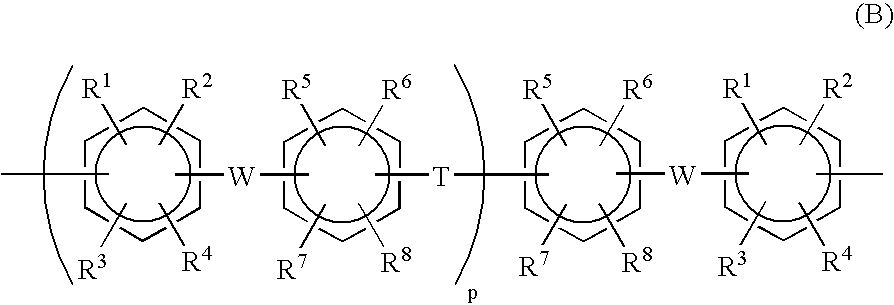Proton conductive composition and proton conductive membrane
a technology of proton conductive membrane and proton conductive composition, which is applied in the direction of conductive materials, fuel cell details, non-aqueous electrolytes, etc., can solve the problem of not allowing penetration of electrodes, and achieve the effect of sufficient generating performance and preventing short circui
- Summary
- Abstract
- Description
- Claims
- Application Information
AI Technical Summary
Benefits of technology
Problems solved by technology
Method used
Image
Examples
synthesis example 1
Preparation of Oligomer
[0108] A 1-L three-necked flask equipped with a stirrer, a thermometer, a cooling tube, a Dean-Stark tube and a three-way nitrogen inlet cock, was charged with 67.3 g (0.20 mol) of 2,2-bis(4-hydroxyphenyl)-1,1,1,3,3,3-hexafluoropropane (bisphenol AF), 60.3 g (0.24 mol) of 4,4′-dichlorobenzophenone (4,4′-DCBP), 71.9 g (0.52 mol) of potassium carbonate, 300 ml of N,N-dimethylacetamide (DMAc) and 150 ml of toluene. With the flask in an oil bath, the contents were reacted by being stirred in a nitrogen atmosphere at 130° C. Reaction was carried out while the water resulting from the reaction was removed as an azeotropic mixture with toluene, outside the system through the Dean-Stark tube. Water almost ceased to occur in about 3 hours, and most of the toluene was removed while gradually raising the reaction temperature from 130° C. to 150° C. After reaction had been made at 150° C. for 10 hours, 10.0 g (0.040 mol) of 4,4′-DCBP was added to carry out reaction for ...
synthesis example 2
Preparation of Polyarylene Copolymer Having Sulfonic Group
[0110] A 1-L three-necked flask equipped with a stirrer, a thermometer, a cooling tube, a Dean-Stark tube and a three-way nitrogen inlet cock, was charged, in a nitrogen atmosphere, with 39.58 g (98.64 mmol) of neo-pentyl 4-[4-(2,5-dichlorobenzoyl)phenoxy]benzenesulfonate (A-SO3 neo-Pe), 15.23 g (1.36 mmol) of the BCPAF oligomer obtained in Synthesis Example 1, 1.67 g (2.55 mmol) of Ni(PPh3)2Cl2, 10.49 g (40 mmol) of PPh3, 0.45 g (3 mmol) of NaI, 15.69 g (240 mmol) of zinc powder and 390 ml of dry NMP. Reaction was carried out by heating the system (finally to 75° C.) with stirring for 3 hours. The polymerization solution was diluted with 250 ml of THF, stirred for 30 minutes, and filtered with use of Celite as filter aid. The filtrate was poured into large excess (1500 ml) of methanol to precipitate the product. The precipitated product was filtered off, air dried, then redissolved in THF / NMP (200 / 300 ml) and precipitated ...
example 1
[0113] The polyarylene with a sulfonic group obtained in Synthetic Example 2 was formed into a film. This film and 5 μm diameter titania particles were placed in a plastic bottle in a volume ratio of 80:20 (% by volume) (film:particles), followed by addition of γ-butyrolactone. The mixture was stirred with a disperser for 20 minutes to give a uniform dispersion.
[0114] The dispersion was cast over a PET film by a bar coater method, and the resultant coating was dried at 80° C. for 30 minutes and then at 140° C. for 60 minutes to give a solid electrolyte film 1 containing 20% by volume titania particles and having a thickness of 20 μm.
[0115] A membrane-electrode assembly including the solid electrolyte film 1 was subjected to the generating endurance test. The test proved that the assembly was capable of generating continuously for at least 1000 hours. Lowering in the terminal voltage after 1000 hours from initiation of the generation was not more than 5%.
PUM
| Property | Measurement | Unit |
|---|---|---|
| particle diameters | aaaaa | aaaaa |
| particle diameters | aaaaa | aaaaa |
| mol % | aaaaa | aaaaa |
Abstract
Description
Claims
Application Information
 Login to View More
Login to View More - R&D
- Intellectual Property
- Life Sciences
- Materials
- Tech Scout
- Unparalleled Data Quality
- Higher Quality Content
- 60% Fewer Hallucinations
Browse by: Latest US Patents, China's latest patents, Technical Efficacy Thesaurus, Application Domain, Technology Topic, Popular Technical Reports.
© 2025 PatSnap. All rights reserved.Legal|Privacy policy|Modern Slavery Act Transparency Statement|Sitemap|About US| Contact US: help@patsnap.com



